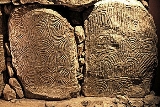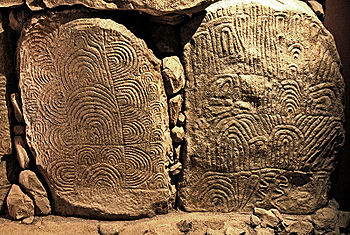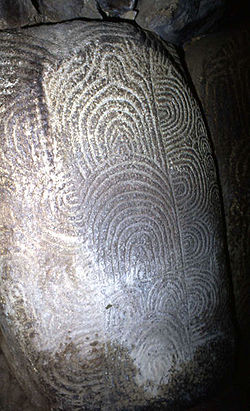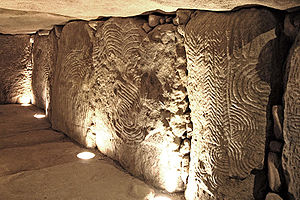
Gavrinis
Encyclopedia

Gulf of Morbihan
The Gulf of Morbihan is a natural harbour on the coast of the Département of Morbihan in the south of Brittany, France. This English name is taken from the French version: le golfe du Morbihan...
in Brittany
Brittany
Brittany is a cultural and administrative region in the north-west of France. Previously a kingdom and then a duchy, Brittany was united to the Kingdom of France in 1532 as a province. Brittany has also been referred to as Less, Lesser or Little Britain...
, France
France
The French Republic , The French Republic , The French Republic , (commonly known as France , is a unitary semi-presidential republic in Western Europe with several overseas territories and islands located on other continents and in the Indian, Pacific, and Atlantic oceans. Metropolitan France...
. It contains the Gavrinis tomb, a megalithic monument notable for its abundance of megalithic art
Megalithic art
Megalithic art refers to the use of large stones as an artistic medium. Although some modern artists and sculptors make use of large stones in their work, the term is more generally used to describe art carved onto megaliths in prehistoric Europe....
in the European Neolithic
Neolithic
The Neolithic Age, Era, or Period, or New Stone Age, was a period in the development of human technology, beginning about 9500 BC in some parts of the Middle East, and later in other parts of the world. It is traditionally considered as the last part of the Stone Age...
. Administratively, it is part of the commune of Larmor-Baden
Larmor-Baden
Larmor-Baden is a commune in the Morbihan department of Brittany in north-western France.-Île de Berder:Île de Berder is a small island in the commune of Larmor-Baden in the département of Morbihan, Brittany, France....
.
Geography

Atlantic Ocean
The Atlantic Ocean is the second-largest of the world's oceanic divisions. With a total area of about , it covers approximately 20% of the Earth's surface and about 26% of its water surface area...
, the island is basically a granite
Granite
Granite is a common and widely occurring type of intrusive, felsic, igneous rock. Granite usually has a medium- to coarse-grained texture. Occasionally some individual crystals are larger than the groundmass, in which case the texture is known as porphyritic. A granitic rock with a porphyritic...
rock outcrop of 750 x 400m dimensions. Its highest point dominates much of the surrounding area.
Name
The name Gavrinis is popularly believed to be derived from the Breton words gavr (goat) and enez (island), thus suggesting a meaning as "goat island". This is probably a false etymologyEtymology
Etymology is the study of the history of words, their origins, and how their form and meaning have changed over time.For languages with a long written history, etymologists make use of texts in these languages and texts about the languages to gather knowledge about how words were used during...
. In documents dating to 1184 and 1202, the island is named as Guirv Enes and Guerg Enes, respectively. The old Breton word Guerg is not related to gavr, but to parallels like Gaul
Gaulish language
The Gaulish language is an extinct Celtic language that was spoken by the Gauls, a people who inhabited the region known as Gaul from the Iron Age through the Roman period...
gwery, or Old Irish
Old Irish language
Old Irish is the name given to the oldest form of the Goidelic languages for which extensive written texts are extant. It was used from the 6th to the 10th centuries, by which time it had developed into Middle Irish....
ferg, signifying "work". Thus, the toponym probably originally meant "the worked island" or "the cultivated
Agriculture
Agriculture is the cultivation of animals, plants, fungi and other life forms for food, fiber, and other products used to sustain life. Agriculture was the key implement in the rise of sedentary human civilization, whereby farming of domesticated species created food surpluses that nurtured the...
island".
Importance

Passage grave
thumb|250px|right|A simple passage tomb in [[Carrowmore]] near [[Sligo]] in IrelandA passage grave or passage tomb consists of a narrow passage made of large stones and one or multiple burial chambers covered in earth or stone. Megaliths are usually used in the construction of passage tombs, which...
, a megalithic monument from the Neolithic
Neolithic
The Neolithic Age, Era, or Period, or New Stone Age, was a period in the development of human technology, beginning about 9500 BC in some parts of the Middle East, and later in other parts of the world. It is traditionally considered as the last part of the Stone Age...
period, belonging to the same broad context as the Breton megaliths of Carnac
Carnac
Carnac is a commune beside the Gulf of Morbihan on the south coast of Brittany in the Morbihan department in north-western France.Its inhabitants are called Carnacois...
and Locmariaquer
Locmariaquer
Locmariaquer is a commune in the Morbihan department in Brittany in north-western France.It lies south of Auray by road.-Coat of arms:This coat of arms was created 30 years ago by the local artist Jean-Baptiste Corlobé...
, and closely connected with the monuments at Brú na Boínne
Brú na Bóinne
is a World Heritage Site in County Meath, Ireland and is the largest and one of the most important prehistoric megalithic sites in Europe.-The site:...
(Ireland
Ireland
Ireland is an island to the northwest of continental Europe. It is the third-largest island in Europe and the twentieth-largest island on Earth...
) and Maes Howe (Orkney). At the time of its construction, c. 3500 BC, the island was still connected with the mainland. The rich internal decorations make Gavrinis one of the major treasuries of European megalithic art
Megalithic art
Megalithic art refers to the use of large stones as an artistic medium. Although some modern artists and sculptors make use of large stones in their work, the term is more generally used to describe art carved onto megaliths in prehistoric Europe....
. The tomb is also remarkable for the care taken in its construction and its good preservation.
History of research
The first excavations took place in 1835, when the internal chamber was discovered. Further research was undertaken by the archaeologist Zacharie Le Rouzic who began restoration work around 1930. Further works took place in the 1960s and 1970s. Charles-Tanguy Leroux, former Director of Breton Antiquities, undertook studies and consolidation works in the 1980s. Further excavation is in the planning stages.Date
The tomb was built relatively late within the French megalithic sequence. Its use ceased around 3000 BC. At that time, the light wooden structures cladding its entrance were burnt, after which part of the mound collapsed, obscuring and blocking the passage. A layer of windblown sand transformed the monument into a simple hillock.The cairn
The stone mound has a diameter of about 50m. The mass of stones forming the cairn is internally structured by a series of walls, subdividing it into separate "ranks". It is a characteristic example of Neolithic dry stone architecture.The chamber
The mound covers a single rectangular (nearly square) slab-built burial chamber, located at the centre of the mound and measuring about 2.5m across. The chamber is built of about 50 carefully placed slabs. The biggest of these is the ceiling slab which weighs nearly 17 tons. Such simple dolmenDolmen
A dolmen—also known as a portal tomb, portal grave, dolmain , cromlech , anta , Hünengrab/Hünenbett , Adamra , Ispun , Hunebed , dös , goindol or quoit—is a type of single-chamber megalithic tomb, usually consisting of...
-type chambers, reached by passages, were very common in Brittany between 4500 and 3000 BC. At the same time, similar monuments were constructed in Normandy
Normandy
Normandy is a geographical region corresponding to the former Duchy of Normandy. It is in France.The continental territory covers 30,627 km² and forms the preponderant part of Normandy and roughly 5% of the territory of France. It is divided for administrative purposes into two régions:...
and Poitou
Poitou
Poitou was a province of west-central France whose capital city was Poitiers.The region of Poitou was called Thifalia in the sixth century....
, in Ireland
Ireland
Ireland is an island to the northwest of continental Europe. It is the third-largest island in Europe and the twentieth-largest island on Earth...
, Britain
Great Britain
Great Britain or Britain is an island situated to the northwest of Continental Europe. It is the ninth largest island in the world, and the largest European island, as well as the largest of the British Isles...
and the Iberian Peninsula
Iberian Peninsula
The Iberian Peninsula , sometimes called Iberia, is located in the extreme southwest of Europe and includes the modern-day sovereign states of Spain, Portugal and Andorra, as well as the British Overseas Territory of Gibraltar...
.

The passage and its art
The chamber is reached from outside by a 14m long corridor or passage. Of the 29 orthostat slabs that form the sides of the passage, 23 are decorated with carved symbols and patterns. Some of the symbols appear to represent non-abstract objectAbstract object
An abstract object is an object which does not exist at any particular time or place, but rather exists as a type of thing . In philosophy, an important distinction is whether an object is considered abstract or concrete. Abstract objects are sometimes called abstracta An abstract object is an...
s, like axes and croziers or staffs. A common horn-like motif may symbolise cattle, a shape conventionally called the shield may be a very stylised human figure. More abstract motifs include zigzag lines, lozenges and snake-like lines.
Reuse of stones
In 1984, it was discovered that the external side of some slabs, now covered by cairn material, is also decorated, but in a different style from their internal face. This decoration must have been applied before the cairn was erected. Archaeologists suspect that at least a number of those slabs may be in secondary use, having formed part of earlier monuments elsewhere. Most strikingly, the top of the chamber's ceiling slab bore the depiction of a bull, the horns of a further animal and a motif known from other monuments that is sometimes interpreted as the depiction of a sperm whaleSperm Whale
The sperm whale, Physeter macrocephalus, is a marine mammal species, order Cetacea, a toothed whale having the largest brain of any animal. The name comes from the milky-white waxy substance, spermaceti, found in the animal's head. The sperm whale is the only living member of genus Physeter...
. Astonishingly, the slab can be joined with the ceiling stones of two other monuments, the Table des Marchands dolmen and the Er Vinglé tomb, at Locmariaquer, at a distance of 4 km (as the crow flies). The three slabs appear to have once formed a massive 14m standing stone
Standing stone
Standing stones, orthostats, liths, or more commonly megaliths are solitary stones set vertically in the ground and come in many different varieties....
, similar to the great broken menhir
Menhir
A menhir is a large upright standing stone. Menhirs may be found singly as monoliths, or as part of a group of similar stones. Their size can vary considerably; but their shape is generally uneven and squared, often tapering towards the top...
of Locmariaquer, which broke or was broken, to be reused as three ceiling slabs, its decorations deliberately obscured.
Replica
A replica of part of the Gavrinis passage with its decorated slabs can be visited in the Museum at the megalithic necropolis of BougonTumulus of Bougon
The Tumulus of Bougon or Necropolis of Bougon is a group of five Neolithic monuments located in Bougon near La-Mothe-Saint-Héray, between Exoudon and Pamproux in Poitou-Charentes, France. Their discovery in 1840 raised great scientific interest...
, (Deux-Sèvres
Deux-Sèvres
Deux-Sèvres is a French département. Deux-Sèvres literally means "two Sèvres": the Sèvre Nantaise and the Sèvre Niortaise are two rivers which have their sources in the department.-History:...
).
See also
- Table des Marchand (LocmariaquerLocmariaquerLocmariaquer is a commune in the Morbihan department in Brittany in north-western France.It lies south of Auray by road.-Coat of arms:This coat of arms was created 30 years ago by the local artist Jean-Baptiste Corlobé...
) - NewgrangeNewgrangeNewgrange is a prehistoric monument located in County Meath, on the eastern side of Ireland, about one kilometre north of the River Boyne. It was built around 3200 BC , during the Neolithic period...
- Maes Howe
- BarnenezBarnenezThe Cairn of Barnenez is a Neolithic monument located near Plouezoc'h, on the Kernéléhen peninsula in northern Finistère, Brittany...
- BougonTumulus of BougonThe Tumulus of Bougon or Necropolis of Bougon is a group of five Neolithic monuments located in Bougon near La-Mothe-Saint-Héray, between Exoudon and Pamproux in Poitou-Charentes, France. Their discovery in 1840 raised great scientific interest...
- Knockroe http://www.megalithicireland.com/Knockroe%20Passage%20Tomb.html
External links
- French government guide to the Morbihan megaliths, excellent illustrations
- Gavrinis Images and comparisons to Newgrange in Ireland

